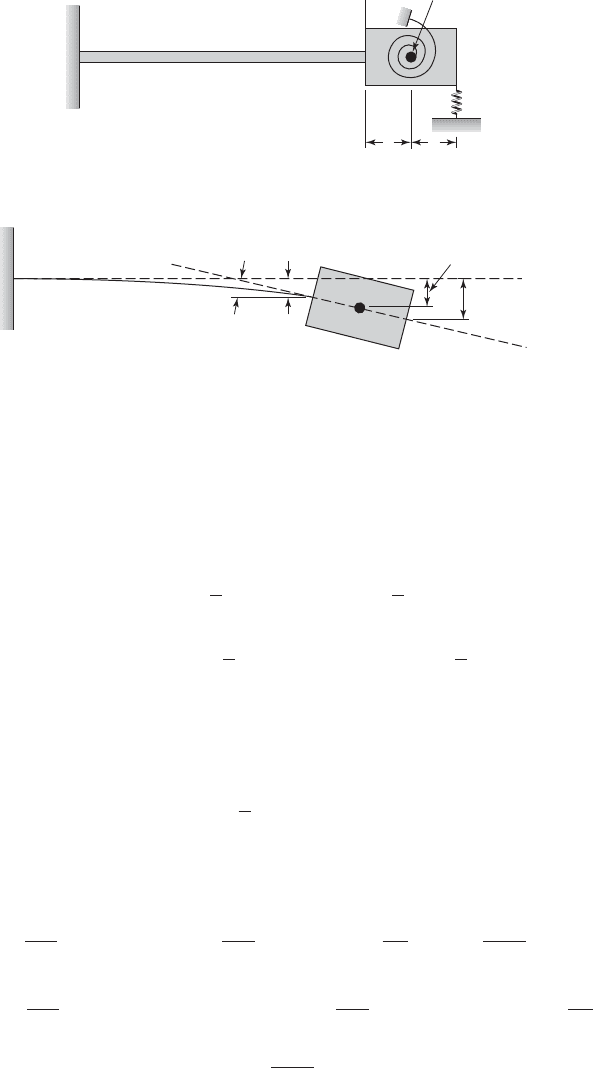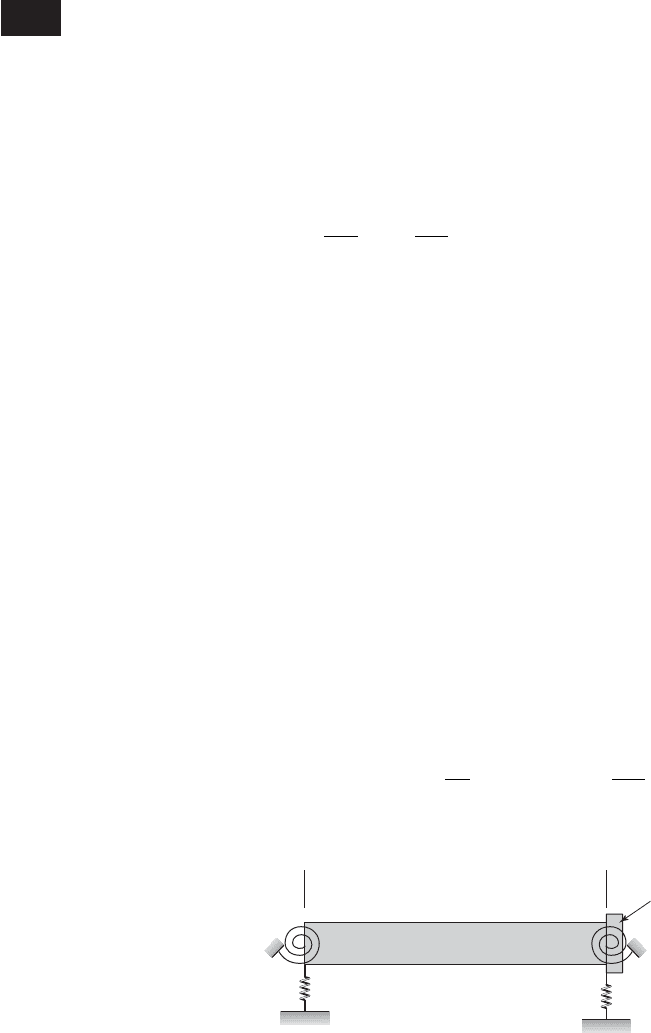Balakumar Balachandran, Magrab E.B. Vibrations
Подождите немного. Документ загружается.


In addition, in Sections 9.3.1 and 9.3.2, we assume that the axial load is ab-
sent and that the elastic foundation is not present; that is,
(9.49)
The boundary conditions simplify accordingly.
The effect of axial load and elastic foundation on the free oscillations of
beams is considered in Section 9.3.3, and beams with varying cross-sections
are considered in Section 9.3.5. In light of the assumptions given by Eqs.
(9.48) and (9.49), Eq. (9.40) reduces to
(9.50)
Equation (9.50), along with the appropriate boundary conditions given by
Eqs. (9.47) or chosen from Table 9.1, represent the governing equations of
a damped beam
13
subjected to transverse loading. We study the free response
of the undamped system first, and then use this as a basis to determine the re-
sponse of the damped system subjected to dynamic forcing in Section 9.4.
Before proceeding to the next section, a few comments about Eq. (9.50)
are in order. This equation is a partial differential equation with a fourth-
order spatial derivative and a second-order time derivative. Since the highest
spatial derivative is fourth order, four boundary conditions are needed. Simi-
larly, since the highest time derivative is second order, two initial conditions
are needed. In the rest of this chapter, it is assumed that appropriate informa-
tion is available to completely define the response determined as a solution of
Eq. (9.50).
EXAMPLE 9.1
Boundary conditions for a cantilever beam with an extended mass
14
Consider a uniform cantilever beam that has an extended rigid mass M
2
at-
tached to its free end as shown in Figure 9.6. Comparing this system to the
system shown in Case 9 in Table 9.1, we note the mass center is located away
from x L and the discrete springs are attached away from x L. The
mass has a mass moment of inertia J
2
about its center of mass. In addition,
a linear spring with stiffness k
2
is attached to the free end of the mass and
a torsion spring with stiffness k
t2
is attached to the center of the mass. In
EI
0
4
w
0x
4
rA
0
2
w
0t
2
f 1x,t 2
p1x,t 2 0
and
k
f
0
560 CHAPTER 9 Vibrations of Beams
13
Although the beam interior is undamped, due to the presence of damping elements at the
boundaries, the beam system is considered a damped system.
14
D. Zhou, “The vibrations of a cantilever beam carrying a heavy tip mass with elastic supports,”
J. Sound Vibration, Vol. 206, No. 2, pp. 275–279 (1997); H. Seidel and L. Csepregi, “Design
optimization for cantilever-type accelerometers,” Sensors and Actuators, Vol. 6, pp. 81–92
(1984); C. L. Kirk and S. M. Wiedemann, “Natural Frequencies and Mode Shapes of a Free-Free
Beam with Large End Mass,” J. Sound Vibration, Vol. 254, No. 5, pp. 939–949, 2002.

Figure 9.6b, the transverse displacements are shown at several locations on
the extended mass. With this information, we shall obtain an expression for
the discrete Lagrangian G
L
at the right end of the beam. Using Eq. (9.21) as a
guide, we obtain the following expression for G
L
at x L
(a)
where the prime denotes the derivative with respect to x and the overdot de-
notes the derivative with respect to time. For the system of Figure 9.6, the
function G
B
is obtained from Eq. (9.19) by setting k
f
p f
c
0; that is,
(b)
Upon substituting Eqs. (a) and (b) into Eqs. (9.30b) and (9.31b) and per-
forming the indicated operations, we obtain, respectively,
(c)
1J
2
M
2
d
2
0
2
0
3
w
0x0t
2
d
xL
EI
0
2
w
0x
2
`
xL
ck
2
1d
0
d
1
2w M
2
d
0
0
2
w
0t
2
Ak
t2
k
2
1d
0
d
1
2
2
B
0w
0x
EI
0
3
w
0x
3
`
xL
ck
2
w M
2
0
2
w
0t
2
1d
0
d
1
2k
2
0w
0x
M
2
d
0
0
3
w
0x0t
2
d
xL
G
B
1x,t,w,w
#
,w¿,w
#
¿,w– 2
1
2
3rAw
#
2
EIw–
2
4
1
2
k
2
1w
L
3d
0
d
1
4w¿
L
2
2
1
2
k
t2
w¿
L
2
G
L
1t,w
L
,w
#
L
,w¿
L
,w
#
¿
L
2
1
2
M
2
1w
#
L
d
0
w
#
¿
L
2
2
1
2
J
2
w
#
¿
L
2
9.2 Governing Equations of Motion 561
x 0
x L
k
2
k
t2
w
L
w
L
d
0
w
L
w
L
(d
0
d
1
)w
L
w
L
d
0
d
1
M
2
, J
2
Center of mass
(a)
(b)
FIGURE 9.6
(a) Cantilever beam with an
extended mass attached to its free
end and (b) displacement at several
locations on the extended mass.

When d
1
d
0
0, Eqs. (c) reduce to those given by Eqs. (9.47b) with p c
2
0. The other two boundary conditions are given by the first entry of Table 9.1.
9.3 FREE OSCILLATIONS: NATURAL FREQUENCIES AND MODE SHAPES
9.3.1 Introduction
In this section, free oscillations of undamped, homogeneous and uniform
beams are examined in detail. To this end, we use Eqs. (9.50) and (9.41b) and
set the external nonconservative loading f
nc
(x,t) to zero and obtain the fol-
lowing governing equation of the beam for 0 x L:
(9.51)
In order to keep the discussion general in terms of boundary conditions, we
consider the system shown in Figure 9.7. We place a translation spring with
constant k
1
and a torsion spring with constant k
t1
at x 0 and place a transla-
tion spring with constant k
2
and a torsion spring with constant k
t2
at x L. In
addition, at x L there is a rigid body with a mass M
o
that has a mass mo-
ment of inertia J
o
. Then, from Eqs. (9.47a) with p c
1
M
1
J
1
0, the
boundary conditions at x 0 are
(9.52a)
From Eqs. (9.47a) with p c
2
0, M
2
M
o
, J
2
J
o
, the boundary condi-
tions at x L are
(9.52b)
In writing Eqs. (9.52), we have employed the compact notation that
w
x0
w10,t 2,
0w
0x
`
x0
w¿10,t2,
0
2
w
0x
2
`
x0
w–10,t2,
EIw‡1L,t 2 k
2
w1L,t 2 M
o
w
$
1L,t 2
EIw–1L,t 2k
t2
w¿1L,t 2J
o
w
$
¿1L,t 2
EIw‡10,t 2k
1
w10,t 2
EIw–10,t 2 k
t1
w¿10,t 2
EI
0
4
w
0x
4
rA
0
2
w
0t
2
rAg
562 CHAPTER 9 Vibrations of Beams
x 0 x L
k
1
k
2
k
t1
k
t2
M
o
, J
o
FIGURE 9.7
Beam with spring elements at left
and right boundaries and an inertia
element at the right boundary.

9.3 Free Oscillations 563
and so on. In addition, we have used the fact that EI is constant.
For a given set of initial conditions, the response of the beam governed
by Eqs. (9.51) and (9.52) is expressed as
(9.53)
where w
st
(x) is the static response or the static-equilibrium position and
w
dyn
(x,t) is the displacement measured from the static-equilibrium position.
The static-equilibrium position satisfies the static-equilibrium equation
(9.54)
and the following boundary conditions at x 0
(9.55a)
and the following boundary conditions at x L
(9.55b)
Although the solution of Eq. (9.54) subject to the boundary conditions
Eqs. (9.55) can be found, this is not explicitly carried out here. Nevertheless,
the droop of a beam due to its own weight is given by w
st
(x). Any constant
loading acting on a distributed-parameter system will influence the static-
equilibrium position of that system. For most commonly used structural
materials and geometries, the static deformation w
st
(x) due to gravity and
other static loading is assumed to be small in magnitude and this deformation
is often ignored in the analysis. However, there are cases such as an aircraft
wing, where the static deformation is pronounced and cannot be ignored.
In MEMS, residual stresses due to the fabrication process can lead to a static
deformation.
15
In Sections 3.2 and 7.2, it was shown the static-equilibrium position of a
single degree-of-freedom system is determined by solving an algebraic equa-
tion and the static-equilibrium position of a multi-degree-of-freedom system
is determined by solving a system of algebraic equations, respectively. Here,
by contrast, we find that the static-equilibrium position of a beam is deter-
mined by solving a differential equation.
EIw‡
st
1L 2 k
2
w
st
1L 2
EIw–
st
1L 2k
t2
w¿
st
1L 2
EIw‡
st
10 2k
1
w
st
10 2
EIw–
st
10 2 k
t1
w¿
st
10 2
EI
d
4
w
st
dx
4
rAg
w1x,t 2 w
st
1x 2 w
dyn
1x,t 2
0
3
w
0x0t
2
`
x 0
w
$
¿10,t 2
15
Y. Yee, M. Park, and K. Chun, “A sticking model of suspended polysilicon microstructure in-
cluding residual stress gradient and post release temperature,” J. Microelectromechanical Sys-
tems, Vol. 7, No. 3, pp. 339–344 (1998).

On substituting Eq. (9.53) into Eqs. (9.51) and (9.52) and making use
of Eqs. (9.54) and (9.55), we find that the oscillations about the static-
equilibrium position are described by
(9.56)
subject to the following boundary conditions at x 0
(9.57a)
and the following boundary conditions at x L
(9.57b)
Equation (9.56) is a linear, homogeneous partial-differential equation
that is used to describe the free oscillations of the beam about the static-
equilibrium position. As discussed in the context of finite degree-of-freedom
systems, gravity loading does not appear in the equation governing the
dynamic response w
dyn
(x,t) of the beam. Based on the form of Eq. (9.56), we
assume that there is a separable solution; that is,
(9.58)
where W(x) is a function that depends only on the spatial variable x and G(t)
is a function that depends only on the temporal variable t. By assuming this
form of solution, we are assuming that every point on the beam has the same
time dependence. In other words, the ratio of displacements at two different
points on a beam is independent of time.
On substituting Eq. (9.58) into (9.56) and rearranging the terms, we
obtain
(9.59)
Since the left-hand side consists only of terms that are functions of time and
the right-hand side consists only of terms that are functions of the spatial vari-
able x, the ratio on each side must be a constant; that is,
(9.60)
where l is a constant. Based on the experience gained with free oscillations
of undamped finite degree-of-freedom systems in Sections 4.2 and 7.4, it
is known that the free oscillations of vibratory systems are described by sine
or cosine harmonic functions.
16
Noting that the beam is undamped, and
1
G
d
2
G
dt
2
EI
rAW
d
4
W
dx
4
l
1
G
d
2
G
dt
2
EI
rAW
d
4
W
dx
4
w
dyn
1x,t 2 W1x2G1t 2
EIw‡
dyn
1L,t 2 k
2
w
dyn
1L,t 2 M
o
w
$
dyn
1L,t 2
EIw–
dyn
1L,t 2k
t2
w¿
dyn
1L,t 2 J
o
w
$
¿
dyn
1L,t 2
EIw‡
dyn
10,t 2k
1
w
dyn
10,t 2
EIw–
dyn
10,t 2 k
t1
w¿
dyn
10,t 2
EI
0
4
w
dyn
0x
4
rA
0
2
w
dyn
0t
2
0
564 CHAPTER 9 Vibrations of Beams
16
As discussed in Chapter 4, this will not be true of an unstable vibratory system. In general, for
an undamped linear vibratory system in the absence of rotation, it can be said that unbounded
oscillations do not occur and that the bounded oscillations that do occur are harmonic in form.

assuming that there is no damping in the boundary conditions, we set the con-
stant l as
(9.61)
Upon making use of Eqs. (9.60) and (9.61), we obtain the temporal eigen-
value equation
(9.62)
which has a solution of the form
(9.63)
In the harmonic solution given by Eq. (9.63), G
os
and G
oc
are arbitrary con-
stants that will be determined by the initial conditions and v is an unknown
quantity to be determined. The quantity v, which describes the frequency of
oscillation of the beam in its free state, is called the natural frequency. As we
will see later in this section, there is an infinite number of natural frequencies
for the beam. On substituting Eq. (9.58) into Eq. (9.56) and making use of
Eq. (9.62), we arrive at
(9.64a)
Since Eq. (9.64a) has to be satisfied for all time and for arbitrary G(t) not nec-
essarily zero, the only way this is possible is if we have
(9.64b)
Similarly, substituting Eq. (9.58) into Eq. (9.57) and making use of Eq. (9.62),
we arrive at the following boundary conditions at x 0
(9.65a)
and the following boundary conditions at x L
(9.65b)
Equations (9.64b) and (9.65) represent the spatial eigenvalue problem. As
in the eigenvalue problems encountered in Chapters 4 and 7, the trivial solution
W(x) 0 is a solution of Eqs. (9.64b) and (9.65). However, we are not interested
in this trivial solution, but in determining the special values of v, called the
eigenvalues, for which W(x) will be nontrivial. In the terminology of spatial
eigenvalue problems, these nontrivial functions are called the eigenfunctions. In
the case of the beam, the eigenvalues provide us the natural frequencies and the
eigenfunctions provide us the mode shapes. The natural frequencies and mode
shapes depend on the boundary conditions and the geometry of the beam. This
dependence will be explored in the following sections.
EIW‡1L 2 k
2
W1L 2 v
2
M
o
W1L 2 1k
2
v
2
M
o
2W1L2
EIW–1L 2k
t2
W¿1L 2 v
2
J
o
W¿1L 2 1k
t2
v
2
J
o
2W¿1L 2
EIW‡10 2k
1
W10 2
EIW–10 2 k
t1
W¿10 2
EI
d
4
W
dx
4
rAv
2
W 0
aEI
d
4
W
dx
4
rAv
2
W bG1t2 0
G1t 2 G
os
sin vt G
oc
cos vt
d
2
G
dt
2
v
2
G 0
l v
2
9.3 Free Oscillations 565

9.3.2 Natural Frequencies, Mode Shapes, and
Orthogonality of Modes
We shall now determine the natural frequencies and mode shapes for a gen-
eral set of boundary conditions and discuss an important property of mode
shapes, the orthogonality property. To elaborate on this property and to de-
termine the conditions that go with this property, it is not necessary to deter-
mine explicitly the natural frequencies and mode shapes. Therefore, we first
present a discussion on this property, and then we illustrate how Laplace
transforms with respect to the spatial variable can be used to determine the
natural frequencies and mode shapes for uniform beams subjected to arbitrary
boundary conditions.
Orthogonal Functions
An orthogonal function is defined as follows. If a sequence of real functions
{w
n
(x)}, n 1, 2, . . . , has the property that over some interval
(9.66)
where d
nm
is the Kronecker delta function,
17
then the functions are said to form
an orthogonal set with respect to the weighting functions p
1
(x) and p
2
(x) on that
interval. The quantity is called the norm of the function w
n
(x). Hence, if m
and n are different from each other—that is, we have two different orthogonal
functions—the integral given by Eq. (9.66) evaluates to zero. This property is
analogous to the orthogonality property associated with vectors; that is, the
scalar dot product of two identical vectors is the square of the vector’s magni-
tude, while the scalar dot product of two orthogonal vectors is zero.
In the present context, the mode shapes W
n
(x) will take the place of w
n
(x)
in Eq. (9.66) and the weighting function will be determined by the stiffness
and inertia properties of the system. The material presented here parallels that
presented in Section 7.3.2 for systems with multiple degrees of freedom.
Spatial Eigenvalue Problem in Terms of Nondimensional Quantities
Before proceeding further, we introduce the following notations:
(9.67)m
o
rAL, j
o
m
o
L
2
K
j
k
j
L
3
EI
, B
j
k
tj
L
EI
j 1,2
c
2
b
E/r, r
2
I/A, t
o
L
2
c
b
r
h x/L,
4
v
2
rAL
4
EI
v
2
L
4
c
2
b
r
2
v
2
t
2
o
1N
n
b
a
cp
1
1x 2w
n
1x 2w
m
1x 2 p
2
1x 2
dw
n
1x 2
dx
dw
m
1x 2
dx
ddx d
nm
N
n
566 CHAPTER 9 Vibrations of Beams
17
d
nm
1, n m, d
nm
0, otherwise.

In Eq. (9.67), h is a nondimensional spatial variable, is a nondimensional
frequency coefficient, c
b
is the longitudinal (or bar) speed along the x-axis of
the beam, r is the radius of gyration of the beam’s cross-section about the
neutral axis, m
o
is the mass of the beam, t
o
is a characteristic time of the beam,
and K
j
and B
j
are nondimensional translation and torsion spring constants, re-
spectively. On substituting the appropriate expressions from Eqs. (9.67) into
Eqs. (9.64b) and (9.65), the result is
(9.68)
with the following boundary conditions at h 0
(9.69a)
and the following boundary conditions at h 1
(9.69b)
where the prime () will be used from this point on to denote the derivative
with respect to h. It is noted that in Eqs. (9.68) and (9.69), W(h) has the units
of displacement.
Orthogonality Property of Mode Shapes
We assume that
n
is an eigenvalue and W
n
(h) is the associated eigensolution
or mode shape of the system given by Eqs. (9.68) and (9.69); that is,
(9.70)
and at h 0
(9.71a)
and at h 1
(9.71b)
Let W
m
(h) be another solution of Eqs. (9.68) and (9.69), which corre-
sponds to the mth natural frequency coefficient
m
, where
m
n
. We now
W
n
–¿ 11 2 aK
2
M
o
4
n
m
o
bW
n
11 2
W
n
–112 aB
2
J
o
4
n
j
o
bW
n
¿112
W
n
‡102K
1
W
n
10 2
W
n
–102 B
1
W
n
¿102
d
4
W
n
dh
4
4
n
W
n
0
W‡11 2 aK
2
M
o
4
m
o
bW11 2
W–11 2 aB
2
J
o
4
j
o
bW¿112
W‡10 2K
1
W10 2
W–10 2 B
1
W¿10 2
d
4
W
dh
4
4
W 0
9.3 Free Oscillations 567

multiply Eq. (9.70) by W
m
(h), integrate over the interval 0 h 1, and use
integration by parts to obtain
(9.72)
Performing the same set of operations, but reversing the order of m and n,
we get
(9.73)
After subtracting Eq. (9.73) from Eq. (9.72), the resulting expression is
which is written in expanded form as
(9.74)
Upon substituting the boundary conditions given by Eqs. (9.71) into
Eq. (9.74), we arrive at
(9.75)
Since
n
m
, the expression inside the brackets must equal zero. This
leads to
(9.76a)
1
0
W
m
W
n
dh
M
o
m
o
W
m
11 2W
n
11 2
J
o
j
o
W¿
m
11 2W¿
n
11 2 d
nm
N
n
1
4
m
4
n
2c
1
0
W
m
W
n
dh
M
o
m
o
W
m
11 2W
n
11 2
J
o
j
o
W¿
m
11 2W¿
n
11 2d 0
W¿
m
10 2W –
n
10 2 0
W
n
10 2W‡
m
10 2 W¿
n
11 2W–
m
11 2 W¿
n
10 2W–
m
10 2 W¿
m
11 2W–
n
11 2
1
4
m
4
n
2
1
0
W
m
W
n
dh W
m
11 2W –¿
n
11 2 W
m
10 2W –¿
n
10 2 W
n
11 2W ‡
m
11 2
1
4
m
4
n
2
1
0
W
m
W
n
dh W
m
W
n
–¿ `
0
1
W
n
W
m
–¿ `
0
1
W
n
¿W
m
– `
0
1
W
m
¿W
n
– `
0
1
0
1
0
W
n
–W
m
–dh
4
m
1
0
W
n
W
m
dh 0
1
0
W
n
W
IV
m
dh
4
m
1
0
W
n
W
m
dh W
n
W‡
m
`
1
0
W¿
n
W
m
– `
1
0
1
0
W
m
–W
n
–dh
4
n
1
0
W
m
W
n
dh 0
1
0
W
m
W
IV
n
dh
4
n
1
0
W
m
W
n
dh W
m
W‡
n
`
1
0
W¿
m
W
n
– `
1
0
568 CHAPTER 9 Vibrations of Beams

9.3 Free Oscillations 569
where d
nm
is the Kronecker delta and
(9.76b)
Equation (9.76a) is written as
(9.77)
where d(h 1) is the delta function. Equation (9.77) is a special case of
Eq. (9.66) if we identify x with h, p
1
(x) with 1 (M
o
/m
o
)d(h 1), p
2
(x) with
(J
o
/j
o
)d(h 1), W
n
(h) with w
n
(x), and W
n
(h) with dw
n
(x)/dx.
Equation (9.76a) represents the orthogonality condition for the beam and
the boundary conditions, and the functions W
m
(h) that satisfy this condition
are called orthogonal functions. They can be shown to form a complete set of
orthogonal functions.
18
It is also pointed out that the form of the expression
on the left-hand side of Eq. (9.77) is symmetric in the spatial functions W
n
(h)
and W
m
(h); that is, the form of the equation does not change if the functions
W
n
(h) and W
m
(h) are interchanged. This type of symmetry is characteristic
of self-adjoint systems whose eigenfunctions are known to be orthogonal
functions.
19
Based on Eqs. (9.76) and (9.77), it should be clear that for all of the
boundary conditions shown in Table 9.1, the mode shapes are orthogonal func-
tions. The orthogonality property of the modes was established for beams with
uniform and homogeneous properties; that is, beams with constant flexural
rigidity EI, constant mass density r, and constant area of cross-section A. It can
be shown that an orthogonality condition similar in form to Eqs. (9.76) also ap-
plies to beams with nonuniform and inhomogeneous properties.
Solutions for Natural Frequencies and Mode Shapes
We shall now determine the specific form of W
n
(h) by solving Eqs. (9.68) and
(9.69). In order to find this specific form, we first need to solve for the eigen-
value
n
. To determine this eigenvalue, we need to determine the characteris-
tic equation whose roots will provide us the eigenvalues of the system. The
eigenvalue
n
and the associated eigenfunction W
n
(h) are determined by
solving the boundary-value problem using Laplace transforms. Instead of
J
o
j
o
1
0
W¿
m
1h 2W¿
n
1h 2d1h 1 2dh d
nm
N
n
1
0
c1
M
o
m
o
d1h 1 2dW
m
1h 2W
n
1h 2dh
N
n
1
0
W
2
n
1h 2dh
M
o
m
o
W
2
n
11 2
J
o
j
o
W¿
2
n
11 2
18
E. B. Magrab, ibid, Chapter 1.
19
L. Meirovitch, Principles and Techniques of Vibrations, Prentice Hall, Upper Saddle River, NJ,
Chapter 7 (1997).
